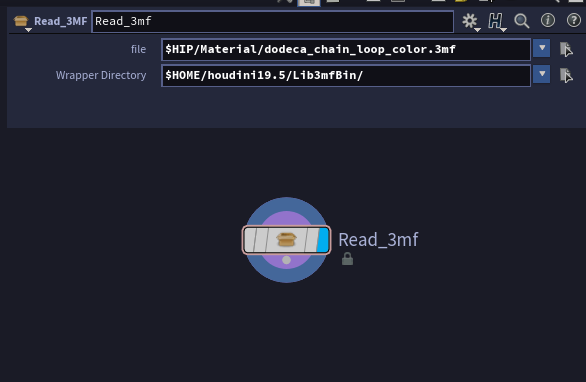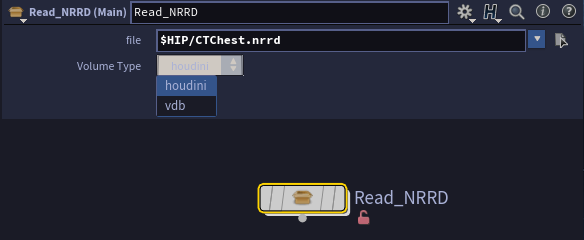Compatibility Plugins for Cutting-Edge Mesh and Volume File Formats with Python
Posted on November 10, 2022 • 7 minutes • 1418 words
Table of contents
During my time developing software for DASH, I occasionally found the need to write my own file interpreters. We used several file formats that were super cutting edge, that our engineering tools and web application packages didn’t have support for yet. In these cases I would need to write custom software to import the files into the software or environment.
3mf and NRRD Readers for Houdini
One of the engineering tools that we used frequently was Houdini, a procedural DCC tool designed for the film and VFX industry. Since it was designed for film and VFX it didn’t always have the built-in capability to import certain volume and 3D printing formats.
What it did have, was a fantastic python API that allowed me to create custom nodes that would support the data that was needed. Using available python libraries I was able to implement full file compatibility into Houdini.
If you’re just looking to use these tools, the title also serves as a link to the repository which has Houdini .otls of the source code ready to install, as well as instructions. If you’re interested in how I worked through processing and interpreting the files, read on!
3mf File Reader
The .3mf file format is short for ‘3D Manufacturing Format’. It’s designed to hold all of the information needed to 3D print a full tray of complex parts, including support for part duplication, color, texture, and priority. Supporting this file format makes 3D printing much easier, so let’s implement it in Houdini.
Fortunately, the lib3mf consortium has bindings available for Python in a lib3mf
package. Awesome! However, you have to load their binary at runtime, which is less fun.
Fortunately, I can just have the use point to the location of the binary for their
operating system and the file they want loaded using Houdini’s built in UI tools, so I
started there.

Once I had all of the inputs I knew I wanted to grab from the user, I started building out the actual logic to read the files. First, we wanted to make sure the user has actually provided all the information we need, and if not, we want to remind them that the program can’t run without their input.
file = digital_asset_node.parm("file").eval()
wrapper_location = digital_asset_node.parm("wrapper").eval()
file_exists = wrapper_exists = False
if os.path.isfile(file):
file_exists = True
elif file != "":
raise hou.Error("Specified file does not exist")
if os.path.exists(wrapper_location):
system = platform.system()
if system == "Linux":
wrapper_file_name = "lib3mf.so"
elif system == "Windows":
wrapper_file_name = "lib3mf.dll"
wrapper_file = os.path.join(wrapper_location, wrapper_file_name)
if os.path.isfile(wrapper_file):
wrapper_exists = True
if file_exists and wrapper_exists:
import_3mf(file, wrapper_file)
This checks for the existance of a file to import, and if the wrapper exists for their correct operating system. Finally, once all of those conditions are met, we can actually start importing the file.
def import_3mf(file, wrapper_file):
# Flags for the types of data contained in the file
cd = False
uv = False
# Boiler plate information to load the 3mf file into their library
wrapper_object = ".".join(wrapper_file.split(".")[:-1])
wrapper = Lib3MF.Wrapper(wrapper_object)
model = wrapper.CreateModel()
reader = model.QueryReader("3mf")
reader.SetStrictModeActive(False)
reader.ReadFromFile(file)
mesh_iterator = model.GetMeshObjects()
# Since point indeces reset per/object in the 3mf library, and don't in Houdini
# We need to keep track of how many points we've already added to the Houdini mesh
point_offset = 0
# Iterate through all unique models in the file
while mesh_iterator.MoveNext():
# Get the data associated with the current mesh
current_resource = mesh_iterator.GetCurrent()
resource_id = current_resource.GetUniqueResourceID()
current_mesh = model.GetMeshObjectByID(resource_id)
vertices = current_mesh.GetVertices()
# Create a houdini point for each vertex in the
for vertex in vertices:
coords = vertex.Coordinates
npt = geo.createPoint()
npt.setPosition(coords)
# Create Triangles and assgin them to the verteces
triangles = current_mesh.GetTriangleIndices()
for i, triangle in enumerate(triangles):
indices = triangle.Indices
p1 = geo.point(point_offset + indices[0])
p2 = geo.point(point_offset + indices[1])
p3 = geo.point(point_offset + indices[2])
nprim = geo.createPolygon()
v1 = nprim.addVertex(p1)
v2 = nprim.addVertex(p2)
v3 = nprim.addVertex(p3)
prop = current_mesh.GetTriangleProperties(i)
# Check if there are any vertex properties, e.g. vertex color and UVs
try:
prop_type = model.GetPropertyTypeByID(prop.ResourceID)
except Lib3MF.ELib3MFException:
continue
if prop_type:
# Read vertex colors from the object into Houdini
if prop_type == Lib3MF.PropertyType.Colors:
# Create the color attribute if it doesn't already exist
if not cd:
geo.addAttrib(hou.attribType.Point, "Cd", [1.0, 1.0, 1.0])
cd = True
color_list = model.GetColorGroupByID(prop.ResourceID)
c1 = color_list.GetColor(prop.PropertyIDs[0])
c2 = color_list.GetColor(prop.PropertyIDs[1])
c3 = color_list.GetColor(prop.PropertyIDs[2])
p1.setAttribValue(
"Cd",
[
int(c1.Red) / 255.0,
int(c1.Green) / 255.0,
int(c1.Blue) / 255.0,
],
)
p2.setAttribValue(
"Cd",
[
int(c2.Red) / 255.0,
int(c2.Green) / 255.0,
int(c2.Blue) / 255.0,
],
)
p3.setAttribValue(
"Cd",
[
int(c3.Red) / 255.0,
int(c3.Green) / 255.0,
int(c3.Blue) / 255.0,
],
)
# Read UV attributes into Houdini
if prop_type == Lib3MF.PropertyType.TexCoord:
# Create the uv property if it doesn't already exist
if not uv:
geo.addAttrib(hou.attribType.Vertex, "uv", [0.0, 0.0])
uv = True
uv_list = model.GetTexture2DGroupByID(prop.ResourceID)
print(uv_list)
uv1 = uv_list.GetTex2Coord(prop.PropertyIDs[0])
print(f"{uv1.U},{uv1.V}")
uv2 = uv_list.GetTex2Coord(prop.PropertyIDs[1])
uv3 = uv_list.GetTex2Coord(prop.PropertyIDs[2])
v1.setAttribValue("uv", [uv1.U, uv1.V])
v2.setAttribValue("uv", [uv2.U, uv2.V])
v3.setAttribValue("uv", [uv3.U, uv3.V])
# After processing the mesh, update the point_offset counter by point size
point_offset += current_mesh.GetVertexCount()
Now, what about exporting you may ask? Well, that’s a good question. But since before I made this tool I had already build a standalone 3mf packaging tool I decided to use Houdini’s built in .obj exporters, whichc supported all of the properties I intended to use, and run the files through the separate tool which has a bunch of additional quality checks built in.
NRRD File Reader
Working with meshes are all well good, but what if you need to read data about a volume?
Well, that’s the problem that the NRRD, or Nearly Raw Raster Data, file format aims to
implement. Much like the lib3mf files, we will still need a file to process, and I’ll
let the user select it themselves from the UI.

Fortunately, unlike lib3mf, I don’t need an extra wrapper file to use the
pynrrd library. I do however, still need to make sure it’s installed. Fortunately,
it’s on PyPI, which means I can just tell Houdini to install it with pip, if the user
hasn’t done so already!
try:
import nrrd
except:
import sys
import subprocess
subprocess.check_call([sys.executable, "-m", "pip", "install", "pynrrd"])
import nrrd
Now, there are definitely better ways to handle dependecy managemnt in Python. I for one really like poetry , but the way Houdini handles it’s dependencies and projects, doesn’t really support a lot of these convenient tools, and I found this a suitable work-around for working with dependency management inside the Houdini engine and its Python interpreter.
Now that we know we have our libraries, we can check that users input is actualy valid as well. If you read the section about the 3mf importer, this should look familiar.
file = digital_asset_node.parm("file").eval()
file_exists = True
if os.path.isfile(file):
file_exists = True
elif file != "":
raise hou.Error("Specified file does not exist")
if file_exists:
read_nrrd(file)
Finally, we can read the data!
def read_nrrd(file):
read_data, header = nrrd.read(file)
# Set the resolution of the volume ndarray
res = header["sizes"]
# Set the distance between each voxel point per axis
x_spacing = abs(max(header["space directions"][0], key=abs))
y_spacing = abs(max(header["space directions"][1], key=abs))
z_spacing = abs(max(header["space directions"][2], key=abs))
# Set the volumes location in space
center = header["space origin"]
# Calculate the total dimensions of the volume
x_size = x_spacing * res[0]
y_size = y_spacing * res[1]
z_size = z_spacing * res[2]
# Calculate the minimum and maximum bounding box location
x_min = center[0] - (x_size / 2)
y_min = center[1] - (y_size / 2)
z_min = center[2] - (z_size / 2)
x_max = center[0] + (x_size / 2)
y_max = center[1] + (y_size / 2)
z_max = center[2] + (z_size / 2)
# Create a bounding box object to size the volume
bounding_box = hou.BoundingBox(x_min, y_min, z_min, x_max, y_max, z_max)
# Create appropriately sized volume object
volume = geo.createVolume(int(res[0]), int(res[1]), int(res[2]), bounding_box)
# Stuff the voxel data into the volume
flattened_data = read_data.flatten("F")
all_voxels = tuple(float(val) for val in flattened_data)
volume.setAllVoxels(all_voxels)
Fortuntaely, both Houdini and the pynrrd library have great support for numpy, which
makes sizing the volumes and reformatting the data to Houdini’s specifications a breeze.
Conclusions
I’ve tried to break up the components of these scripts into, at least somewhat,
digestable pieces but there’s definietly some code-stink any time I try to write
software for Houdini, so if you have any questions about the logic or implementation
feel free to reach out! Ultimately, I hope this write up will de-mystify some of the
pecularities of writing code for Houdini, and give some insight into the lib3mf and
pynrrd libraries as well!

